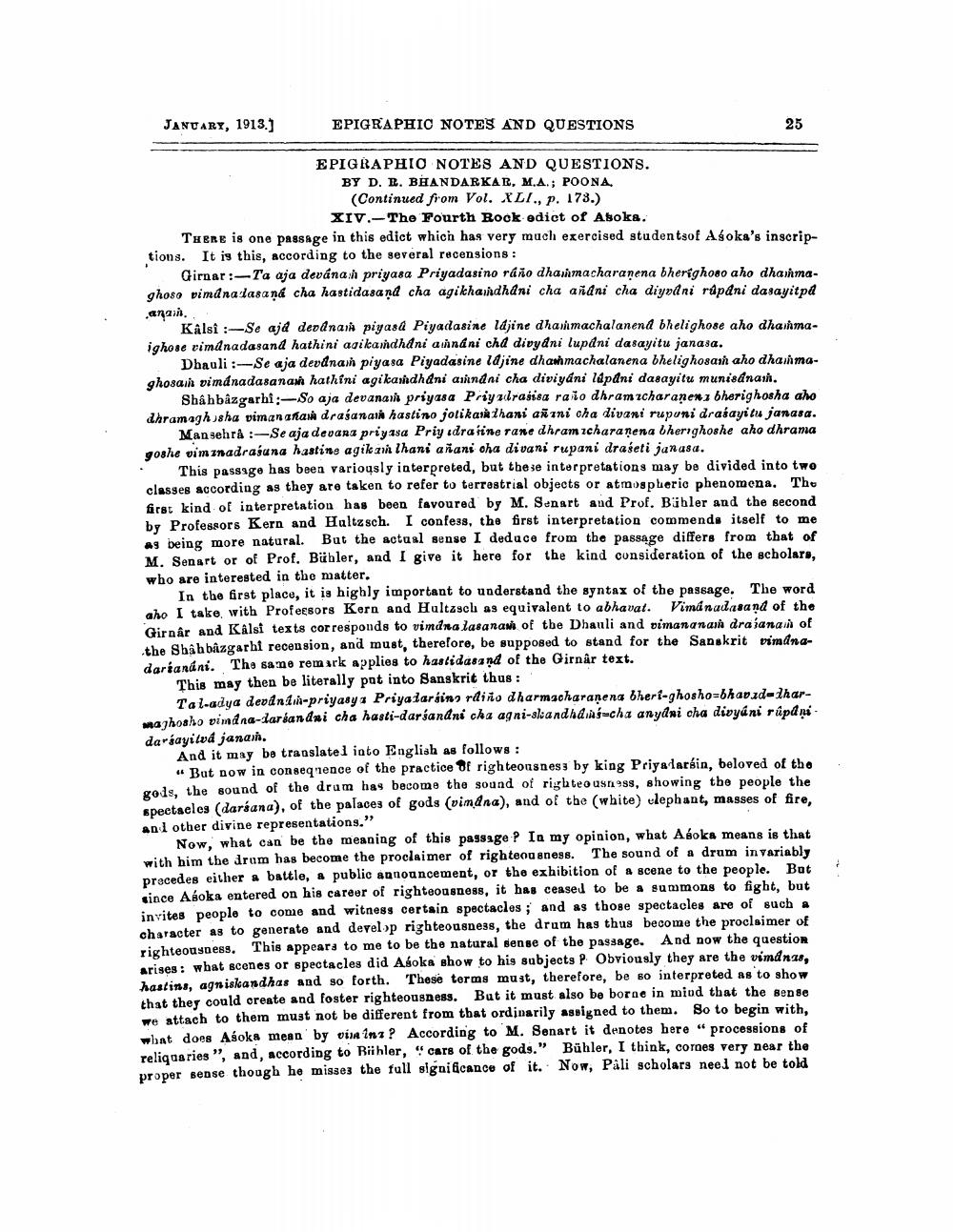________________
JANUARY, 1913.)
EPIGRAPHIC NOTES AND QUESTIONS
25
EPIGRAPHIO NOTES AND QUESTIONS.
BY D. R. BANDARKAR, M.A.; POONA
(Continued from Vol. XLI., p. 173.)
XIV.-The Fourth Book edict of Asoka. There is one passage in this edict which has very much exercised studentsof Asoka's inscriptions. It is this, according to the several recensions :
Girnar:-Ta aja devánasi priyasa Priyadasino ráno dhaimacharanena bherighoso aho dhanmaghoso vimd na lasaná cha hastidasand cha agikhandhani cha anani cha diyvdni rápani dasayitpd anai.
Kalsi :Se ajd ded@nara piyasa Piyadasine idjine dhaimachalanend bhelighose aho dhainmaighose vimanadasand hathini agikandhani aina ni cha divyani lupdni dasayitu janasa.
Dhauli :-Se aja devdnai piyasa Piyadasine idjine dhaumachalanena bhelighosash aho dhaimaghosaji vimdnadasanan hathini agi kasidhani arindni cha diviyani ldpdni dasayitu munisdnani.
Shahbâzgarhi:-So aja devanan priyasa Priyulrasisa raio dhram charanex1 bhorighosha aho dhramaghusha vimananah drasana hastino jotikan Zhani anni cha divani rupuni drasayitu janasa.
Mansehra :--Se aja de vara priyasa Priy idrajine rane dhram zcharañena bherrghoshe aho dhrama goshe vim inadrasuna hastine agikan lhani anani cha divani rupani draseti janasa. . This passage has been variously interpreted, but these interpretations may be divided into two classes according as they are taken to refer to terrestrial objects or atmospheric phenomena. The first kind of interpretation has been favoured by M. Senart and Prof. Bibler and the second by Professors Kern and Haltzsch. I confess, the first interpretation commends itself to me as being more natural. But the actual sense I deduce from the passage differs from that of M. Senart or of Prof. Bühler, and I give it here for the kind consideration of the scholars, who are interested in the matter.
In the first place, it is highly important to understand the syntax of the passage. The word aho I take, with Profesors Kern and Haltzsch as equivalent to abhavat. Vimánadasand of the Girnâr and Kalsi texts corresponds to vindra lasanam of the Dhauli and vimananai drajanail of the Shâh bâzgarhl recension, and must, therefore, be supposed to stand for the Sanskrit vimanadaríandni. The sano remark applies to hastidasand of the Girnar text.
This may then be literally pat into Sanskrit thus :
Tal-adya devantn-priyasya Priyadarsino rdino dharmacharaṇena bheri-ghosho=bhavad-tharmaghosho vimd na-darsandni cha hasti-daríandni cha agni-sland hd.ns-cha anyani cha divyáni rûpd ni darsayitvá janan.
And it may be translateliato English as follows:
" But now in consequence of the practice of righteousness by king Priyalarsin, beloved of the gods, the sound of the dram has become the sound of righteousness, showing the people the speetaeles (darsana), of the palaces of gods (vindna), and of the (white) elephant, masses of fire, and other divine representations."
Now, what can be the meaning of this passage P In my opinion, what Aboka means is that with him the drum has become the proclaimer of righteousness. The sound of a drum in variably precedes either a battle, a public announcement, or the exhibition of a scene to the people. But since Aboka entered on his career of righteousness, it has ceased to be a summons to fight, but invites people to come and witness certain spectacles ; and as those spectacles are of such character as to generate and develop righteousness, the drum has thus become the proclaimer of righteousness. This appears to me to be the natural sense of the passage. And now the question arises : what scenes or spectacles did Asoka show to his subjects P Obviously they are the vimdnas, hastins, agniskandhas and so forth. These terms must, therefore, be so interpreted as to show that they could create and foster righteousness. But it must also be borne in mind that the sense we attach to them must not be different from that ordinarily assigned to them. So to begin with, what does Asoka mean by virr Inz ? According to M. Senart it denotes here “ processions of reliqdaries ", and, according to Brihler, "cars of the gods." Bühler, I think, cornes very near the proper sense though he misses the full significance of it. Now, Pali scholars neel not be told




